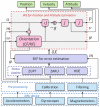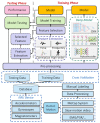IMU-Based Monitoring for Assistive Diagnosis and Management of IoHT: A Review
- PMID: 35885736
- PMCID: PMC9318359
- DOI: 10.3390/healthcare10071210
IMU-Based Monitoring for Assistive Diagnosis and Management of IoHT: A Review
Abstract
With the rapid development of Internet of Things (IoT) technologies, traditional disease diagnoses carried out in medical institutions can now be performed remotely at home or even ambient environments, yielding the concept of the Internet of Health Things (IoHT). Among the diverse IoHT applications, inertial measurement unit (IMU)-based systems play a significant role in the detection of diseases in many fields, such as neurological, musculoskeletal, and mental. However, traditional numerical interpretation methods have proven to be challenging to provide satisfying detection accuracies owing to the low quality of raw data, especially under strong electromagnetic interference (EMI). To address this issue, in recent years, machine learning (ML)-based techniques have been proposed to smartly map IMU-captured data on disease detection and progress. After a decade of development, the combination of IMUs and ML algorithms for assistive disease diagnosis has become a hot topic, with an increasing number of studies reported yearly. A systematic search was conducted in four databases covering the aforementioned topic for articles published in the past six years. Eighty-one articles were included and discussed concerning two aspects: different ML techniques and application scenarios. This review yielded the conclusion that, with the help of ML technology, IMUs can serve as a crucial element in disease diagnosis, severity assessment, characteristic estimation, and monitoring during the rehabilitation process. Furthermore, it summarizes the state-of-the-art, analyzes challenges, and provides foreseeable future trends for developing IMU-ML systems for IoHT.
Keywords: IMU; Internet of Health Things (IoHT); disease diagnosis; machine learning; motion monitoring.
Conflict of interest statement
The authors declare no conflict of interest.
Figures






Similar articles
-
Tensor-Based ECG Anomaly Detection toward Cardiac Monitoring in the Internet of Health Things.Sensors (Basel). 2021 Jun 17;21(12):4173. doi: 10.3390/s21124173. Sensors (Basel). 2021. PMID: 34204575 Free PMC article.
-
IoT-Enabled Gait Assessment: The Next Step for Habitual Monitoring.Sensors (Basel). 2023 Apr 19;23(8):4100. doi: 10.3390/s23084100. Sensors (Basel). 2023. PMID: 37112441 Free PMC article. Review.
-
Potent Blockchain-Enabled Socket RPC Internet of Healthcare Things (IoHT) Framework for Medical Enterprises.Sensors (Basel). 2022 Jun 8;22(12):4346. doi: 10.3390/s22124346. Sensors (Basel). 2022. PMID: 35746127 Free PMC article.
-
Application of Internet of Medical/Health Things to Decentralized Clinical Trials: Development Status and Regulatory Considerations.Front Med (Lausanne). 2022 Jun 6;9:903188. doi: 10.3389/fmed.2022.903188. eCollection 2022. Front Med (Lausanne). 2022. PMID: 35733872 Free PMC article.
-
Smart Home-based IoT for Real-time and Secure Remote Health Monitoring of Triage and Priority System using Body Sensors: Multi-driven Systematic Review.J Med Syst. 2019 Jan 15;43(3):42. doi: 10.1007/s10916-019-1158-z. J Med Syst. 2019. PMID: 30648217
Cited by
-
Human-centred artificial intelligence for mobile health sensing: challenges and opportunities.R Soc Open Sci. 2023 Nov 15;10(11):230806. doi: 10.1098/rsos.230806. eCollection 2023 Nov. R Soc Open Sci. 2023. PMID: 38026044 Free PMC article. Review.
-
Gait Alteration in Individual with Limb Loss: The Role of Inertial Sensors.Sensors (Basel). 2023 Feb 7;23(4):1880. doi: 10.3390/s23041880. Sensors (Basel). 2023. PMID: 36850475 Free PMC article. Review.
-
Functional Monitoring of Patients With Knee Osteoarthritis Based on Multidimensional Wearable Plantar Pressure Features: Cross-Sectional Study.JMIR Aging. 2024 Nov 25;7:e58261. doi: 10.2196/58261. JMIR Aging. 2024. PMID: 39586093 Free PMC article.
-
Assessing Changes in Motor Function and Mobility in Individuals with Parkinson's Disease After 12 Sessions of Patient-Specific Adaptive Dynamic Cycling.Sensors (Basel). 2024 Nov 19;24(22):7364. doi: 10.3390/s24227364. Sensors (Basel). 2024. PMID: 39599140 Free PMC article. Clinical Trial.
-
Insights into motor impairment assessment using myographic signals with artificial intelligence: a scoping review.Biomed Eng Lett. 2025 Jun 5;15(4):693-716. doi: 10.1007/s13534-025-00483-7. eCollection 2025 Jul. Biomed Eng Lett. 2025. PMID: 40621607 Free PMC article. Review.
References
-
- Fan Y.J., Yin Y.H., Da Xu L., Zeng Y., Wu F. IoT-Based Smart Rehabilitation System. IEEE Trans. Ind. Inform. 2014;10:1568–1577.
-
- Life Sciences|Vicon Motion Capture for Biomechanics. [(accessed on 27 May 2022)]. Available online: https://www.vicon.com/applications/life-sciences/
-
- GAITRite|World Leader in Temporospatial Gait Analysis. [(accessed on 27 May 2022)]. Available online: https://www.gaitrite.com/
-
- Bhuiyan M.N., Rahman M.M., Billah M.M., Saha D. Internet of Things (IoT): A Review of Its Enabling Technologies in Healthcare Applications, Standards Protocols, Security, and Market Opportunities. IEEE Internet Things J. 2021;8:10474–10498. doi: 10.1109/JIOT.2021.3062630. - DOI
Publication types
Grants and funding
- 2018YFB2002700/National Key Research and Development Plan Foundation
- XDA22020100/CAS (Chinese Academy of Sciences) Leading Science and Technology (category A) Project
- 2019T3015/CAS (Chinese Academy of Sciences) STS (Science and Technology Service Network Initiative) Project
- 61803017/National Natural Science Foundation of China
- 61827802/National Natural Science Foundation of China
LinkOut - more resources
Full Text Sources
Miscellaneous

